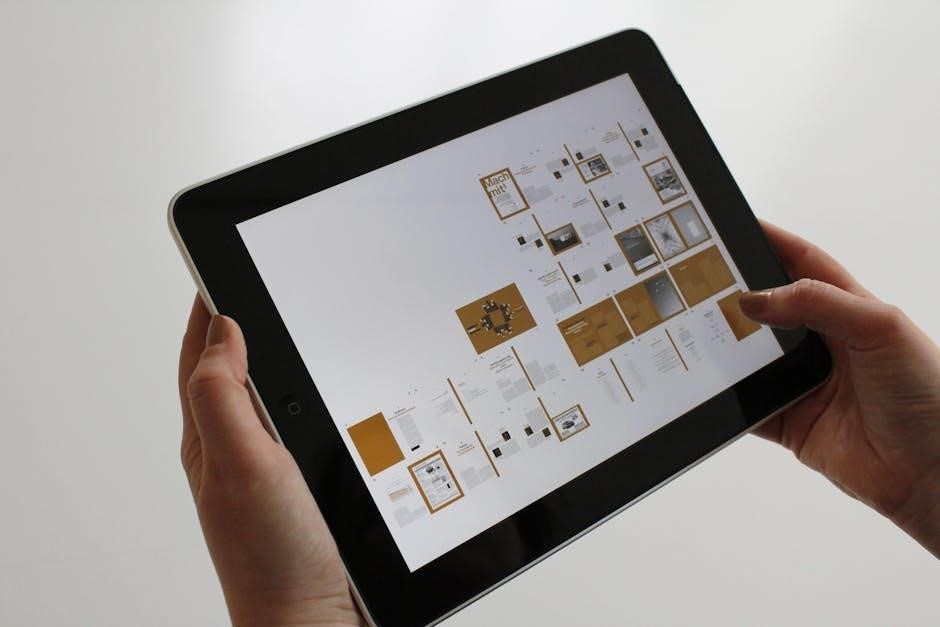The OP-1 is a revolutionary, portable synthesizer designed for creative sound exploration. It combines a 4-pole and 1-pole synthesizer engine with FM synthesis, offering endless sonic possibilities. Its compact design and intuitive interface make it perfect for musicians and producers seeking inspiration on the go. With an internal FM antenna and robust feature set, the OP-1 is a powerhouse for crafting unique sounds and workflows.
Overview of the OP-1 Synthesizer
The OP-1 is a compact, portable synthesizer designed for creative sound design and music production. It features four main modes: Synth, Drum, Tape, and Mixer, each offering unique functionalities. Equipped with a 4-pole and 1-pole synthesizer engine, FM synthesis capabilities, and an internal FM antenna, the OP-1 delivers versatile sound-shaping options. Its intuitive interface and robust feature set make it ideal for both beginners and experienced musicians. With built-in tape recording and layering capabilities, the OP-1 allows for seamless workflow and inspiration on the go, supported by a long-lasting battery for uninterrupted creativity.
Key Features and Capabilities
The OP-1 boasts a range of innovative features, including its dual synthesizer engines, 4-pole and 1-pole, offering deep sound design possibilities. It supports FM synthesis, enabling complex timbres and textures. The device includes eight tape tracks for recording and layering sounds, with each tape providing six minutes of recording time. Equipped with a built-in mixer, the OP-1 allows precise balancing of multiple tracks. Its compact design integrates a color-coded interface for intuitive navigation, while an internal FM antenna ensures wireless connectivity. These features collectively make the OP-1 a versatile and powerful tool for music creation and performance.

Getting Started with the OP-1
Unboxing the OP-1 reveals a compact, intuitive design. Power it on to explore its vibrant interface. Start by navigating through its modes and experimenting with sounds and settings.
Unboxing and Initial Setup
Unboxing the OP-1 reveals a sleek, compact design with a durable build. Inside, you’ll find the unit, a USB cable, and a quick-start guide. Before powering on, ensure all components are accounted for. The initial setup involves charging the battery using the provided USB cable. Connect to a computer or a 5V USB charger for charging. Once charged, power on the device and familiarize yourself with the interface. The OP-1 is ready to use right out of the box, with no additional software installation required for basic functionality.
Powering On and Basic Navigation
Power on the OP-1 by holding the power button until the screen lights up. The device will boot into the start screen, displaying the current mode. Use the numeric keypad to select options and the encoder wheel to scroll through menus. The arrow keys navigate left, right, up, and down, while the ‘OK’ button confirms selections. The ‘BY’ button cycles through views, and the ‘YES/NO’ keys handle confirmation or cancellation. Familiarize yourself with these controls to seamlessly explore the OP-1’s features and begin creating music right away.
Understanding the User Interface
The OP-1 features a sleek, intuitive interface with a high-contrast color OLED screen, providing clear real-time feedback. The numeric keypad allows quick selection of options, while the encoder wheel enables smooth scrolling and parameter adjustment. Arrow keys facilitate navigation between modes and functions. The ‘OK’ button confirms selections, and the ‘BY’ button toggles between views. This design ensures efficient workflow, making it easy to access and manipulate sounds, tracks, and effects. The interface is minimal yet powerful, streamlining creativity and technical adjustments alike. Its logical layout helps users focus on music production without unnecessary complexity.

Core Modes of the OP-1
The OP-1 features four primary modes: Synth, Drum, Tape, and Mixer. Each mode offers distinct tools for sound design, rhythm creation, recording, and mixing, enhancing workflow versatility.
Synth Mode: Creating Sounds
Synth Mode is the heart of the OP-1, offering a versatile 4-pole and 1-pole synthesizer engine. Users can craft unique sounds by adjusting oscillators, filters, and envelopes. The T1-T4 knobs provide precise control over parameters like waveforms, octave, and resonance. With FM synthesis capabilities, you can create dynamic and complex timbres. The engine’s flexibility allows for everything from deep basses to soaring leads. By layering and tweaking settings, musicians can achieve distinctive textures that redefine their creative vision. This mode empowers artists to explore endless sonic possibilities with intuitive and powerful tools.
Drum Mode: Building Rhythms
Drum Mode transforms the OP-1 into a dynamic rhythm generator. It allows users to create and customize drum patterns using the keyboard for triggering sounds. The 4-pole and 1-pole synthesizer engines can generate a wide range of percussive tones, from sharp snares to deep kicks. With 12 drum patterns and 12 steps per pattern, you can craft intricate beats. Adjust parameters like tuning, decay, and level using the A1 and A2 knobs. Assign different sounds to each key for layered percussion. Real-time recording and visual feedback on the display make it easy to experiment and refine your rhythms. This mode is perfect for producers seeking to build unique beats and explore electronic drum sounds.
Tape Mode: Recording and Layering
Tape Mode is the heart of the OP-1’s workflow, enabling you to record and layer sounds directly onto a virtual 6-minute tape. It supports up to 8 tapes, each acting as a separate project for building tracks. Use the keyboard to trigger sounds while recording, and layer them seamlessly. Adjust levels, pan, and effects in real time. The tape interface allows for intuitive editing, with the ability to overdub, erase, or start anew. This mode is perfect for crafting full tracks or experimenting with ideas, making it a cornerstone of the OP-1’s creative process.
Mixer Mode: Balancing Your Mix
Mixer Mode provides comprehensive control over your track’s levels, panning, and effects. Adjust individual track volumes, pan audio signals for stereo depth, and fine-tune effects settings. The interface offers a clear overview, allowing precise balancing of each element. Use the mixer to enhance clarity, prevent volume conflicts, and achieve a polished sound. It’s an essential tool for refining your mix, ensuring every layer sits perfectly within the overall composition, and preparing your track for export.

Advanced Sound Design
The OP-1’s advanced sound design capabilities allow for intricate synthesis and modulation. Its 4-pole and 1-pole engines, alongside FM synthesis, enable deep, dynamic sound shaping and experimentation.
Using the 4-Pole Synthesizer Engine
The OP-1’s 4-pole synthesizer engine delivers rich, resonant low-pass filtering, ideal for crafting deep basses and textures. Its versatility allows for precise sound shaping, with adjustable resonance for added depth. Users can explore a wide range of tonal possibilities, from smooth pads to aggressive leads. The engine’s intuitive controls enable dynamic modifications, making it a cornerstone of the OP-1’s sound design capabilities. By mastering the 4-pole engine, creators can unlock complex, evolving timbres that elevate their music production.
Exploring the 1-Pole Synthesizer Engine
The 1-pole synthesizer engine offers a simpler yet effective approach to sound design, with a high-pass filter for unique tonal shaping. It excels in creating bright, percussive sounds and atmospheric textures. The engine’s minimal design makes it less resource-intensive, allowing for efficient use in complex projects. By adjusting its parameters, users can craft sharp, dynamic sounds that cut through mixes. The 1-pole engine complements the OP-1’s versatility, providing a distinct sonic palette for experimental and modern music production. Its simplicity and effectiveness make it a valuable tool for both novice and advanced sound designers.
Mastering FM Synthesis
FM synthesis is a powerful tool for creating dynamic, evolving sounds. The OP-1’s FM engine allows you to modulate frequencies using multiple operators, resulting in rich, complex timbres. Start by assigning operators to act as carriers or modulators, then experiment with routing and ratios. Adjust the envelope generators to shape the modulation over time. For metallic or percussive sounds, use higher modulation indices. Explore the built-in algorithms to unlock unique textures. Layer FM with other engines for depth. Real-time tweaking via the hardware controls enhances the creative process, making FM synthesis on the OP-1 both intuitive and inspiring.
Integrating External Samples
The OP-1 allows seamless integration of external samples, enhancing your creative palette. Use the USB port to transfer WAV files into the device. Samples can be assigned to any engine or used in Drum Mode for custom kits. Edit and process samples using the internal effects and modulation tools. Layering external samples with synthesized sounds creates depth and uniqueness. Trigger samples via the keyboard or sequencer for dynamic live performances. This feature bridges the gap between sampling and synthesis, offering endless possibilities for sound design and composition on the OP-1.

Effects and Modulation
The OP-1 offers versatile effects like reverb, delay, and distortion. Apply these to tracks or master output for depth. LFOs and envelopes provide dynamic sound shaping, essential for transforming your audio with precision and creativity.
Applying Effects to Your Sounds
The OP-1 allows you to enhance your sounds with a variety of built-in effects, including reverb, delay, and distortion. These effects can be applied to individual tracks or the master output, giving you control over the depth and texture of your music. Using the T3 knob, you can adjust effect levels in real-time, creating dynamic changes during playback or recording. Experiment with layering effects to achieve unique soundscapes, and use the mixer mode to fine-tune your sound. This flexibility makes the OP-1 a powerful tool for shaping your audio and bringing your creative vision to life.
Using LFOs for Dynamic Changes
The OP-1’s LFOs (Low Frequency Oscillators) add dynamic movement to your sounds by modulating parameters like pitch, amplitude, and filters. Assign LFOs using the T4 key, which controls LFO/G-force, allowing you to shape sounds over time. Sync LFOs to your project’s BPM for precise timing or set them to free-run for organic variations. Choose from various waveforms, including sine, square, and random, to create unique modulations. Use LFOs to add vibrato, tremolo, or rhythmic interest, enhancing your tracks with depth and complexity. Experiment with different LFO assignments to unlock new sonic possibilities.
Envelope Generators: Shaping Your Sound
Envelope generators in the OP-1 allow you to shape the progression of your sounds over time. Use the T2 key to adjust the attack, decay, sustain, and release (ADSR) of your envelopes, creating dynamic changes in amplitude, filter cutoff, or pitch. This feature is essential for crafting sounds that evolve naturally, from sharp, punchy synth lines to smooth, ambient pads. By tailoring the envelope settings, you can add depth and character to your sounds, making them more engaging and lifelike. Experiment with different envelope configurations to create unique sonic textures that stand out in your music.

Recording and Workflow
The OP-1’s tape-based workflow allows you to build tracks intuitively. Record sounds, layer them, and refine your mix with ease. Use the internal FM antenna for inspiration and experiment with creative layering techniques to craft unique compositions.
Recording Tracks on Tape
Recording on the OP-1 is intuitive and creative. Use Tape Mode to capture sounds directly to one of eight available tapes, each offering up to six minutes of recording time. The tape interface resembles a classic tape deck, allowing you to start and stop recordings with a press of a button. While recording, you can tweak parameters in real-time to add dynamic changes. This hands-on approach makes the OP-1 ideal for experimenting with ideas and building tracks organically. The ability to layer sounds and overdub makes it easy to craft complex compositions without losing the spontaneity of your creative process.
Layering Sounds for Depth
Layering sounds is a core feature of the OP-1, allowing you to build rich and complex textures. Using Tape Mode, you can stack multiple takes on a single tape, blending synths, drums, and external samples seamlessly. The tape interface lets you trigger overdubs or adjust levels in real-time, creating dynamic depth. Each tape can hold multiple layers, enabling you to craft intricate compositions. This intuitive process encourages experimentation, making it easy to add nuance and dimension to your music. The OP-1’s ability to layer sounds is a key tool for creating immersive and engaging tracks.
Exporting Your Work
Exporting your creations from the OP-1 is seamless and efficient. You can transfer your tracks via USB or Wi-Fi, ensuring high-quality audio preservation. The OP-1 supports various formats, including WAV, making it easy to integrate your work into larger projects. Tracks are organized by tape and date, simplifying navigation. The device’s portability and intuitive interface allow you to share your music effortlessly. Whether for further production or final distribution, the OP-1’s export capabilities ensure your creative vision reaches its audience in pristine condition. This feature underscores the OP-1’s role as a comprehensive tool for modern music production.

Hardware and Connectivity
The OP-1 features a compact, portable design with 8-track tape functionality and USB connectivity. It supports external gear via MIDI and includes a built-in FM antenna for wireless audio sharing, ensuring versatile creative options on the go.
Understanding the Hardware Components
The OP-1 is a compact, portable synthesizer featuring a 4-pole and 1-pole synthesizer engine, plus FM synthesis capabilities. It includes 7 stereo synthesizer engines and an internal FM antenna for wireless audio sharing. The device has 8 tapes, each offering 6 minutes of recording time, and supports external gear via MIDI. Connectivity options include USB for data transfer and a 3.5mm headphone jack for audio output. The OP-1 also features a built-in speaker and is powered by a rechargeable battery, with the option to use a standard 5V USB charger for convenience. Its durable design ensures longevity and portability for creators on the go.
Connecting External Gear
The OP-1 offers versatile connectivity options for integrating external gear. Use the USB port to connect MIDI controllers or interface with computers for data transfer. The 3.5mm headphone jack can also serve as an audio output or input for routing sounds through external effects. Additionally, the OP-1 supports external samples, allowing you to import and utilize sounds from other devices. For synchronization, external gear can be connected via MIDI, ensuring seamless integration with your studio setup. This flexibility makes the OP-1 a hub for creative workflows, enabling you to expand its capabilities with external tools and devices.

Using the Internal FM Antenna
The OP-1 features an internal FM antenna, enabling wireless communication and data transfer. This antenna allows for seamless integration with external devices and enhances the portability of the synthesizer. It supports real-time monitoring and control, making it ideal for live performances or field recordings. The FM antenna also facilitates the transfer of samples and patches wirelessly, streamlining your workflow. This feature is particularly useful for musicians who value mobility and convenience without compromising on functionality. By leveraging the FM antenna, you can unlock new creative possibilities and expand the OP-1’s capabilities in various musical environments.

Tips and Tricks
Explore the OP-1’s hidden features to maximize creativity. Use the FM antenna for wireless connectivity and experiment with layering sounds for depth. Regularly update firmware to access new features and ensure optimal performance. Utilize the tape mode effectively for live recording and looping. Experiment with different synthesizer engines to craft unique sounds. Take advantage of the built-in effects to enhance your mixes. Don’t forget to optimize battery life by adjusting screen brightness and disabling unused features. Troubleshoot common issues by resetting the device or reinstalling firmware. Engage with the OP-1 community for inspiration and workflow hacks. Stay updated on the latest software updates to unlock new functionalities and improvements. Keep your OP-1 well-maintained to ensure longevity and reliability. Discover new techniques by exploring the user interface and experimenting with various modes. Use external samples to expand your sound palette and create diverse tracks. Explore the LFO and envelope generators to add dynamic changes to your sounds. Balance your mix efficiently using the mixer mode for professional-grade results. Record and layer sounds strategically to build complex compositions. Export your work seamlessly for further production or sharing. Connect external gear to enhance your workflow and expand creative possibilities. Learn to navigate the interface quickly to streamline your creative process. Experiment with different recording techniques to capture unique textures and tones. Stay organized by managing your patches and samples effectively. Engage with online tutorials and forums to learn advanced techniques. Backup your work regularly to prevent data loss. Explore the OP-1’s portability by creating music in various environments. Keep your OP-1 firmware updated to access the latest features and improvements. Use the internal FM antenna for wireless communication and data transfer. Experiment with the synthesizer engines to create a wide range of sounds. Utilize the effects section to add depth and character to your tracks. Record and layer sounds effectively to build intricate compositions. Optimize your workflow by familiarizing yourself with the user interface. Engage with the OP-1 community for tips, resources, and support. Regularly clean and maintain your OP-1 to ensure optimal performance. Explore the drum mode for creating dynamic rhythms and beats. Use the mixer mode to balance your tracks and achieve a professional mix. Experiment with the tape mode for live recording and looping. Take advantage of the OP-1’s portability to create music anywhere. Use the internal FM antenna for wireless connectivity and data transfer. Keep your OP-1 updated with the latest software for new features and improvements. Engage with the OP-1 community for inspiration and workflow hacks. Optimize your battery life by adjusting settings and disabling unused features. Troubleshoot common issues quickly to maintain your creative flow. Use external gear to expand your sound and enhance your workflow. Explore the LFO and envelope generators for dynamic sound shaping. Balance your mix efficiently using the mixer mode. Record and layer sounds strategically to build complex tracks. Export your work seamlessly for further production or sharing. Connect external devices to enhance your creative process. Navigate the interface efficiently to streamline your workflow. Experiment with different techniques to capture unique sounds and textures. Stay organized by managing your patches and samples effectively. Engage with online resources for advanced techniques and troubleshooting. Backup your work regularly to prevent data loss. Explore the OP-1’s portability by creating music in various settings. Keep your OP-1 updated for the latest features and improvements. Use the internal FM antenna for wireless communication. Experiment with the synthesizer engines for diverse sound creation. Utilize the effects section to enhance your tracks. Record and layer sounds effectively for intricate compositions. Optimize your workflow by mastering the user interface. Engage with the OP-1 community for support and inspiration. Regularly maintain your OP-1 for optimal performance. Explore the drum mode for dynamic rhythms. Use the mixer mode for professional-grade mixes. Experiment with the tape mode for live recording. Take advantage of the OP-1’s portability for music creation anywhere. Use the internal FM antenna for wireless connectivity. Keep your OP-1 updated for new features and improvements. Engage with the OP-1 community for tips and resources. Optimize battery life by adjusting settings. Troubleshoot issues quickly to maintain creativity. Use external gear to enhance your workflow. Explore the LFO and envelope generators for dynamic changes. Balance your mix efficiently using the mixer mode. Record and layer sounds strategically. Export your work seamlessly. Connect external devices for enhanced creativity. Navigate the interface efficiently. Experiment with techniques for unique sounds. Stay organized by managing your files. Engage with online resources for advanced techniques. Backup your work regularly. Explore the OP-1’s portability. Keep your OP-1 updated. Use the internal FM antenna. Experiment with synthesizer engines. Utilize the effects section. Record and layer sounds. Optimize your workflow. Engage with the community. Maintain your OP-1. Explore the drum mode. Use the mixer mode. Experiment with the tape mode. Take advantage of portability. Use the internal FM antenna. Keep your OP-1 updated. Engage with the community. Optimize battery life. Troubleshoot issues. Use external gear. Explore the LFO and envelope generators. Balance your mix. Record and layer sounds. Export your work. Connect external devices. Navigate the interface. Experiment with techniques. Stay organized. Engage with resources; Backup your work. Explore portability. Keep updated. Use the FM antenna. Experiment with engines. Utilize effects. Record and layer. Optimize workflow. Engage with community. Maintain OP-1. Explore drum mode. Use mixer mode. Experiment with tape mode. Take advantage of portability. Use FM antenna. Keep updated. Engage with community. Optimize battery. Troubleshoot. Use external gear. Explore generators. Balance mix. Record and layer. Export. Connect devices. Navigate interface. Experiment. Stay organized. Backup. Explore. Keep updated. Use antenna. Experiment. Utilize effects. Record. Optimize. Engage. Maintain. Explore. Use mixer. Experiment. Take advantage. Use antenna. Keep updated. Engage. Optimize. Troubleshoot. Use gear. Explore. Balance. Record. Export. Connect. Navigate. Experiment. Stay. Backup. Explore. Keep. Use. Experiment. Utilize. Record. Optimize. Engage. Maintain. Explore. Use. Experiment. Take. Use. Keep. Engage. Optimize. Troubleshoot. Use; Explore. Balance. Record. Export. Connect. Navigate. Experiment. Stay. Backup. Explore. Keep. Use. Experiment. Utilize. Record. Optimize. Engage. Maintain. Explore. Use. Experiment. Take. Use. Keep. Engage. Optimize. Troubleshoot. Use. Explore. Balance. Record. Export. Connect. Navigate. Experiment. Stay. Backup. Explore. Keep. Use. Experiment. Utilize. Record. Optimize. Engage. Maintain. Explore. Use. Experiment. Take. Use. Keep. Engage. Optimize. Troubleshoot. Use. Explore. Balance. Record. Export. Connect. Navigate. Experiment. Stay. Backup. Explore. Keep. Use. Experiment. Utilize. Record. Optimize. Engage. Maintain. Explore. Use. Experiment. Take. Use. Keep. Engage. Optimize. Troubleshoot. Use. Explore. Balance. Record. Export. Connect. Navigate. Experiment. Stay. Backup. Explore. Keep. Use. Experiment. Utilize. Record. Optimize. Engage. Maintain. Explore. Use. Experiment. Take. Use. Keep. Engage. Optimize. Troubleshoot. Use. Explore. Balance. Record. Export. Connect. Navigate. Experiment. Stay. Backup. Explore. Keep. Use. Experiment. Utilize. Record. Optimize. Engage. Maintain. Explore. Use. Experiment. Take. Use. Keep. Engage. Optimize. Troubleshoot. Use. Explore. Balance. Record. Export. Connect. Navigate. Experiment. Stay. Backup. Explore. Keep. Use. Experiment. Utilize. Record. Optimize. Engage. Maintain. Explore. Use. Experiment. Take. Use. Keep. Engage. Optimize. Troubleshoot. Use. Explore. Balance. Record. Export. Connect. Navigate. Experiment. Stay. Backup. Explore. Keep. Use. Experiment. Utilize. Record. Optimize. Engage. Maintain. Explore. Use. Experiment. Take. Use. Keep. Engage. Optimize. Troubleshoot. Use. Explore. Balance. Record. Export; Connect. Navigate. Experiment. Stay. Backup. Explore. Keep. Use. Experiment. Utilize. Record. Optimize. Engage. Maintain. Explore. Use. Experiment. Take. Use. Keep. Engage. Optimize. Troubleshoot. Use. Explore. Balance. Record. Export. Connect. Navigate. Experiment. Stay. Backup. Explore. Keep. Use. Experiment. Utilize. Record. Optimize. Engage. Maintain. Explore. Use. Experiment. Take. Use. Keep. Engage. Optimize. Troubleshoot. Use. Explore. Balance. Record; Export. Connect. Navigate. Experiment. Stay. Backup. Explore. Keep. Use. Experiment. Utilize. Record. Optimize. Engage. Maintain. Explore. Use. Experiment. Take. Use. Keep. Engage. Optimize. Troubleshoot. Use. Explore. Balance. Record. Export. Connect. Navigate. Experiment. Stay. Backup. Explore. Keep. Use. Experiment. Utilize. Record. Optimize. Engage. Maintain. Explore. Use. Experiment. Take. Use. Keep. Engage. Optimize. Troubleshoot. Use. Explore. Balance. Record. Export. Connect. Navigate. Experiment. Stay. Backup. Explore. Keep. Use. Experiment. Utilize. Record. Optimize. Engage. Maintain. Explore. Use. Experiment. Take
Optimizing Battery Life
To maximize the OP-1’s battery life, ensure you use a 5V USB charger for charging. Keep the screen brightness at a moderate level to conserve power. Disable the internal FM antenna when not in use to reduce battery drain. Avoid overcharging, as this can degrade the battery over time. Use power-saving features like turning off unused modes or lowering the volume. Regularly update your firmware, as newer versions often include battery optimizations. Store the device in a cool, dry place when not in use to maintain battery health. By following these tips, you can enjoy extended creative sessions with your OP-1.
Troubleshooting Common Issues
If your OP-1 isn’t turning on, ensure the battery is fully charged using a 5V USB charger. Check for loose connections or damage to the power port. For distorted audio, verify that the volume levels in both the OP-1 and connected devices are balanced. If the screen freezes, restart the device by holding the power button for 10 seconds. Connectivity issues with external gear can often be resolved by resetting the MIDI settings or updating the firmware. Regularly cleaning the ports and avoiding extreme temperatures can prevent hardware malfunctions. Always refer to the user manual for specific solutions to ensure optimal performance.
Creative Workflow Hacks
To optimize your OP-1 workflow, experiment with layering sounds from different engines and modes. Use the master track for transposing and syncing patterns seamlessly. Assign LFOs to unexpected parameters like filter cutoff or pitch for dynamic variations. Record snippets in Tape Mode and rearrange them creatively. Utilize the internal FM antenna for unique signal routing. Explore reverse effects by playing tapes backward. For live performances, pre-save your favorite presets and navigate using the encoder. These hacks streamline your process, allowing you to focus on musical expression and innovation. They enhance your ability to craft compelling sounds and sequences efficiently.
The OP-1 is a versatile, portable synthesizer empowering musicians to create unique sounds anywhere. Its intuitive design and robust features make it a must-have for sound exploration and production.

Final Thoughts on the OP-1
The OP-1 is a groundbreaking synthesizer that seamlessly blends portability with powerful sound design. Its unique workflow and versatility make it a favorite among electronic musicians and producers. Despite its complexity, the intuitive interface ensures creativity flows effortlessly. With constant community support and updates, the OP-1 remains a timeless tool for music creation. Its ability to layer sounds, integrate external samples, and apply dynamic effects sets it apart, offering endless possibilities for artistic expression and innovation in music production.
Community Resources and Support
The OP-1 benefits from a vibrant community and extensive support resources. Online forums, tutorials, and user-generated content provide endless inspiration and troubleshooting tips. Reddit and specialized music production communities often share patches, workflows, and creative hacks. Additionally, the manufacturer offers regular software updates and detailed documentation; Workshops and live streams further enhance the learning experience. With a strong emphasis on collaboration, the OP-1 community fosters innovation and mutual growth, making it easier for users to unlock the device’s full potential and stay connected with fellow musicians and producers worldwide.



